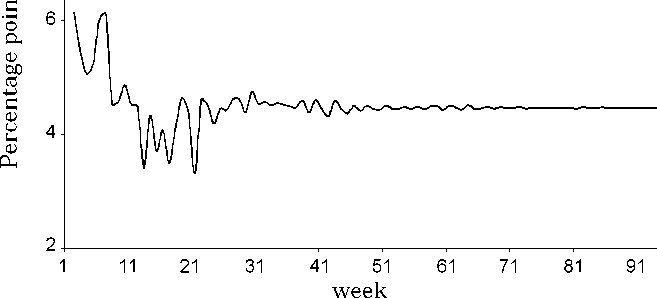Carlos A. Ibarra
implications from these results were discussed in Section I: the
observed reaction of the interest rate differential to a rise in the
exchange rate may represent a stumbling block for the adoption of an
anti-cyclical monetary policy, and it may also compromise the output
stabilizing properties of the floating regime in the presence of capital
account shocks.
Figure 2. Interest rate differential dynamic response to a 10% currency
depreciation.

III. Explaining the link
This section offers an interpretation of the observed pattern of
interest rate-exchange rate correlations in the Mexican float; the
interpretation focuses on how an inflation-averse central bank may
react to an exogenous currency depreciation, and notes the
implications for the behavior of local interest rates, if private agents
incorporate the central bank reaction function into their expectations
formation process.15
15 The analysis assumes that the central bank reaction function is at least imperfectly
known (and credible) within the private sector.
18
More intriguing information
1. Evolutionary Clustering in Indonesian Ethnic Textile Motifs2. The Macroeconomic Determinants of Volatility in Precious Metals Markets
3. The Clustering of Financial Services in London*
4. Skills, Partnerships and Tenancy in Sri Lankan Rice Farms
5. The name is absent
6. Nurses' retention and hospital characteristics in New South Wales, CHERE Discussion Paper No 52
7. A Multimodal Framework for Computer Mediated Learning: The Reshaping of Curriculum Knowledge and Learning
8. Wirkung einer Feiertagsbereinigung des Länderfinanzausgleichs: eine empirische Analyse des deutschen Finanzausgleichs
9. The Role of Evidence in Establishing Trust in Repositories
10. Momentum in Australian Stock Returns: An Update